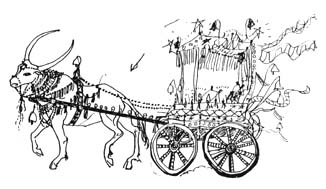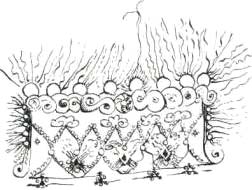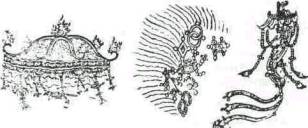Dharma Flower Sutra
With Commentary of Tripitaka Master Hua
Translated into English by Bhiksuni Heng Yin
Reviewed by Bhiksuni Heng Ch’ih
Sutra:
At
that time, the Elder, seeing that all his sons have gotten out safely and are
seated on the ground at the crossroads, is without further obstruction, his
mind is at peace, and he is filled with joy.
Commentary:
At that time, the Elder/the Buddha, seeing that
all his, sons have gotten out safely and are seated on the ground at the
crossroads/The Buddha saw the living beings had gotten out of the burning house
and were sitting on the ground at the crossroads. The crossroads represents
the method of contemplation of the Four Truths: the method of contemplation
of suffering, the method of contemplation of origination, the method of
contemplation
of extinction, and the wisdom of the Way. "On the ground" means that,
in cultivating the Four Truths to certify to the fruit, one severs entirely
the delusions of views and thought in the three realms. "Seated"
means they have certified to the fruit and do not seek further progress.
Certifying to the first fruit, one does not seek the second; certifying to the
second fruit one does not seek the third, and so on. One just sits there and
stops.
People in the three realms are as if tied up by
the revolving wheel of the six paths. Now, seated at the crossroads they have
transcended the revolving wheel. What is meant by his mind at peace. The
Buddha's heart was at peace, because he had seen all living beings safely get
out of the burning house and certify to the fruit of Arhatship. He was filled
with joy/because the disciples had avoided the disaster. What disaster? That of
being burned by the eight sufferings, five skandhas, six senses, twelve places,
and the eighteen realms--the various kinds of suffering—and so the Buddha was
filled with joy.
A father may have sons or daughters who have to undergo some
danger or trouble. When he hears that his sons and daughters have escaped
danger, he is very happy. This is like now, everyone here is very vigorous in
studying the Buddhadharma and comes to listen to the Dharma. During the day
they work, and it's very tiring. When time comes for the Sutra lecture, no
matter how far away they are, they come to listen. This causes your teacher's
heart to be very happy. He thinks, "These students of the Dharma are so
sincere." If none of you came to hear the Buddhadharma as I was lecturing
here, it would be like when Dharma Master Yin-Kuang lectured in Nanking-only
one person was in the audience, night after night. Finally, he spoke with him
and said, "So you find my Sutra lectures interesting, do you?"
The man replied, "I
don't have any idea what you are talking about. I don't understand any of
it."
"Then what are you
doing here?" said the Master Yin-Kuang.
"I'm waiting for you
to finish so I can put the chairs away," he said.
Master Yin kuang's heart
was pained. "I thought I had a real friend here when all the time there
wasn't a single one!" Master Yin-Kuang had a lot of Way virtue. He went
into seclusion on Mount Pu-T’ou for eighteen years and saw no guests in all
that time. What was he doing those eighteen years? Reading the Tripitaka. Later
he wrote many articles. They are extremely good, because he developed his
wisdom by reading the Tripitaka. He was the Thirteenth Patriarch of the Pure
Land School. He had a lot of virtuous practice, yet no one listened to him
lecture on the Sutras. Why not? Because he didn't do a lot of advertising or
pressure people into coming. He never put ads in the paper.
Now, when I am lecturing in
Chinese and so many Westerners come to listen, my lectures are translated into
English. Whose merit is this? The translators'. If no one translated, no one
would know what I was saying. So I am very happy.
A Story:
Don't Let Your
House Burn Down!
Speaking of children
fighting to get out of the burning house, that reminds me of a story. There was
once an old married couple who cultivated the Pure Land Dharma-door. They
recited "Namo Amitabha Buddha" everyday. Someone told them,
"When you recite, you should get the Buddha-recitation samadhi. After you
obtain that samadhi, when the wind blows, it won't blow on you, and the rain
won't fall on you. At that time you will certainly gain great advantage."
One day, the old couple's
daughter-in-law had to go to work. She couldn't find a babysitter for her
three and four year old children, so she gave them to the old couple to look
after. The children were very mischievous and started playing with matches,
lighting little fires. The old man told the old lady, "Go tell the kids
not to light fires. They could burn the house down!"
The woman said, "You just keep minding trivial
matters. How can you expect to attain the Buddha-recitation samadhi that way?
The Buddha-recitation samadhi means you can't pay attention to any external
matters at all. What are you doing watching over the kids?"
The old man thought,
"All right. I'll just forget it," and continued his recitation.
"If I keep reciting the Buddha's name, it will generate enough merit to
keep the house from catching on fire."
So the two of them kept
reciting until, finally, the house did catch on fire! The old couple didn't
even know, because they weren't paying any attention. When a neighbor came over
to put out the fire, he saw the house was half-burned already and the other
half was going fast, but the old couple was just sitting there reciting the
Buddha's name. "How can you ignore the children, let the house burn down,
and not even get out yourselves?" he cried.
The old man glanced at his
wife and said, "See? I told you the kids were playing with fire, and you
said to pay no attention to it but to concentrate on getting the
Buddha-recitation
samadhi. The house has burned down; have you got the samadhi?"
The old woman said,
"Well, why wasn't the recitation effective? We recited and the house
burned down anyway. Probably there's nothing efficacious about recitation at
all." Actually, she was just
superstitious. Kids don't know what is going on. They have to be watched over. You
can't just let them play with fire. Thus, a perfectly good home turned into a
burning house. Although they didn't get out themselves, luckily a good knowing
advisor was able to rescue them at the last minute.
Now, we are talking about
getting out of the burning house; we shouldn't act as stupidly and
superstitiously as that old couple. Don't think that just because you recite
the Buddha's name there will be no fires. Recitation brings its own merit and
virtue, but if you don't watch over the children, the danger of fire is still
ever-present.
Someone asks, "The
Sutra says that if one who recites the name of Kuan-yin Bodhisattva happens to
enter into a great fire, the fire will not burn them. Why, when they were
reciting
Amitabha Buddha did the house catch on fire?"
The Sutra is referring to
one who accidentally "happens" to enter a great fire. If someone is
standing there while the house accidentally catches fire, that situation differs
from the former. The first is a fire, which could not be prevented. The latter
is one, which the old man already knew about, but ignored. They knew the kids
might start a fire, but paid them no mind. Thus, the house caught fire.
Students of the Buddhadharma shouldn't be like that
old couple. Don't think that you can rely on reciting the Buddha's name and
nothing
will happen. That's just being stupid. Reciting the Buddha's name is reciting
the Buddha's name, but if something happens, you have to be prepared. It is
said, "If you are prepared, there are no emergencies."
Sutra:
Then
the children all spoke to their father saying, "Father, the fine playthings you
promised us a while ago, the sheep carts, the deer carts, and the ox carts,
please give them to us now."
Commentary:
This is the section of text in which the children all demand their
carts. The three carts are an analogy for the positions of the Three Vehicles.
Because they wish to obtain the Three Vehicles, they must transcend the three
realms. Once one has transcended the three realms, the Three Vehicle fruits are
ultimately unobtainable. The Three Vehicles are all the provisional teaching,
ultimately unobtainable and non-existent, during the Vaipulya Teaching Period
those of the Three Vehicles were scolded by the Buddha. During the Vaipulya
Period, those who studied the Storehouse teaching, the pervasive teaching, and
the Separate teaching were all reprimanded. He told them, "You are
withered sprouts and sterile seeds! You are all just self-ending Arhats who
only watch over themselves. You are corrupt elements. You have no guts at all.
When I teach you, you pay no attention and you don't even follow the rules. You
don't practice any of the Dharma methods I teach you. You are so
lazy!"
Then he spoke in praise of the Perfect Teaching. He said, "You
of the Perfect Teaching are not bad. You have a bit of spunk." He
rewarded those of the Perfect Teaching, those beings with potential, which is
perfectly penetrating without obstruction. "They really cultivate well.
Their skill has about matured."
During the Vaipulya Period the Buddha scolded the partial and the
small and praised the great and rewarded the Perfect.
During the Prajna Period of the Buddha's teaching a process of
selection went on, to see who had the Great Vehicle dispositions and which had
the Small Vehicle dispositions. All the disciples went through many selection
processes. So the Buddha, in several decades, taught and transformed Sages who
had certified to the fruit, obtained Arhatship and cultivated the Bodhisattva
Vehicle. This gradual process of transformation took several decades.
The
Dharma Flower Sutra itself says, "The expedients are not real." This
means that the three types of provisional dharmas taught previously were
nothing but expedients. They are not real, actual Dharma. You should not
misunderstand. Before, you were not ready to receive the true Dharma, and so I
did not teach it to you. Now, in the Dharma Flower Assembly the truth is
coining out, the genuine Dharma is being spoken. Sariputra very respectfully
requested the Buddha three times to speak the Sutra, until the Buddha finally
agreed to speak it. The three requests are what is represented in the analogy
by the words: "asking for the three carts," the deer carts, the sheep
carts, and the ox carts. They want the Three Vehicles from the Buddha.
Sariputra and the entire
assembly were extremely sincere and earnest in their request that the Buddha
speak the true Dharma. The three requests refers to the Sound Hearers, the
Conditioned-Enlightened Ones and the Bodhisattvas asking for the carts. The
children want their toys.
Previously, the three types
of provisional dharmas were taught; now the one real Dharma is being taught.
That is the Great Vehicle, which is for living beings with the Great Vehicle
potential. They have brought forth the resolve to cultivate the Great Vehicle,
to go from the small towards the great. However, we must realize that during
the Vaipulya Period those of the Three Vehicles received a lot of scoldings
from the Buddha. He taught and transformed them for a long time. Sometimes the
Buddha reasoned with them and other times he upbraided them. However, they
didn't know what to do. There were living beings then who wanted to seek the
Great Vehicle Buddhadharma, but didn't know how to go about asking for it. It
was not until the Prajna Assembly, when Prajna was being taught, that "the
teaching was passed on and the wealth was bequeathed." The teaching
passed from the Small Vehicle to the Great Vehicle, just as a father will hand
down his wealth to his children.
In the Prajna period, when
the teaching was passed on, the living beings didn't know ultimately whether or
not they could obtain the wonderful Great Vehicle Dharma. It was at this point
that they got the idea to seek the Great Vehicle. Although the idea arose, they
didn't understand until the Dharma Flower Assembly when Sariputra earnestly
requested three times, by speaking up and asking for the carts. Thus this
section is the children speaking up and demanding the carts. They said, Father,
the fine playthings you promised us a while ago, the sheep carts, deer carts,
and the ox carts, please give them to us now/Daddy, you promised to give us
those neat toys. We want them right now!"
Sutra:
O Sariputra, at that time the Elder gives
to all of his sons, equally, a great cart.
Commentary:
Sakyamuni Buddha calls out again, O Sariputra, at
that time, the Elder gives to all of his sons/The sons represent all living
beings. Because all beings are equal, it says, "all the sons." Equal
means that they are equal with the Buddha. Living beings and the Buddha are equal.
Living beings and the mind are also equal. This is an analogy showing that all living
beings have the Buddha nature and all can become Buddhas.
|




